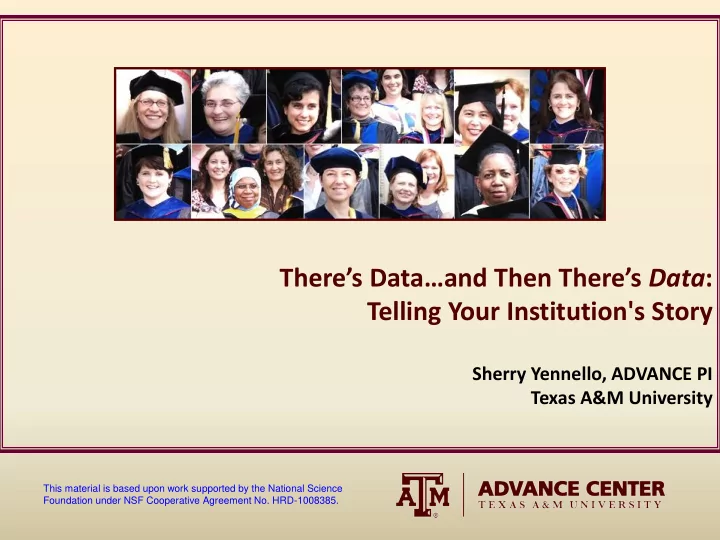

There’s Data…and Then There’s Data : Telling Your Institution's Story Sherry Yennello, ADVANCE PI Texas A&M University This material is based upon work supported by the National Science Foundation under NSF Cooperative Agreement No. HRD-1008385.
Important questions How do we increase the number of women? Are women recruited at the same rate as men? Are women tenured at the same rate as men? Are women retained at the same rate as men? 2
NSF Reporting Requirements 2 Broad Requirements: 1. Annually report data related to progress toward the goals of your program 2. Use Toolkit Guidelines a. NSF Indicators b. Salary c. Space d. Start-up Packages 3
Toolkit includes guidelines for what NSF requires 1. Standardized cross-sectional data for cross-institutional comparison 2. Relatively straightforward and quick (once you have the data) 3. Snap-shot, a single point in time 4. Best for descriptive studies 5. No causality or trend analysis 4
NSF Indicators – Table 3 • No problem with promotion 5
NSF Indicators – Table 6 • No problem with attrition 6
What we knew… or thought we knew What We Thought We Knew Female faculty are not being denied tenure at a higher rate than male faculty. Retention is not a problem at TAMU. On average, 95% of tenured or tenure-track faculty are retained from one year to the next. 7
Going Beyond the Toolkit to Tell the Story Your university’s story is complex, unique, and needs to be fully understood to bring about institutional transformation Survival Analysis • Say what? • Time to event (Public Health) • Duration Analysis (Economics) • Event History Analysis (Sociology) • Two common statistical methods • Kaplan-Meier analysis (non-parametric) • Cox proportional hazards regression model (semi-parametric) • Answers the question: • W hat proportion of a population will “survive” to an event? 9
Baseline Survival Rates for Tenure- Track Faculty in Engineering 10
Probabilities of Promotion and Separation for STEM Associate Professors Probabilities of Promotion and Separation All STEM .2 .15 .1 .05 0 0 2 4 6 8 10 Years as TAMU Associate Professor Female Probability of Promotion Male Probability of Promotion Female Probability of Separation Male Probability of Separation 11
What We Know Now What We Thought We Knew What We Know Now As we explored the data on a deeper Female faculty are not being denied level, we realized that some faculty tenure at a higher rate than male are counseled-out along the path to faculty. tenure. Retention is not a problem at TAMU. Survivability has been significantly lower for female faculty than for On average, 95% of tenured or male faculty in our College of tenure-track faculty are retained Engineering. from one year to the next. Female faculty do not leave after Female faculty are leaving right after getting tenure disproportionate to tenure their male counterparts 12
Take Home Message • You must meet NSF reporting requirements • Higher level statistical analysis can help you understand the data (and tell your institution’s story) 14
advance.tamu.edu Sherry Yennello, PI yennello@comp.tamu.edu 979.845.1141 Lori Taylor, Evaluation Team Leader lltaylor@tamu.edu 979.458.3015
Recommend
More recommend